Certification of financial statements
Department of the Treasury statement of financial performance
Department of the Treasury statement of financial position
Department of the Treasury statement of cash flows
Schedule of commitments
Schedule of contingencies
Department of the Treasury schedule of administered items
Administered cash flows
Administered commitments
Administered contingencies
Statement of activities administered on behalf of government
Notes to and forming part of the financial statements
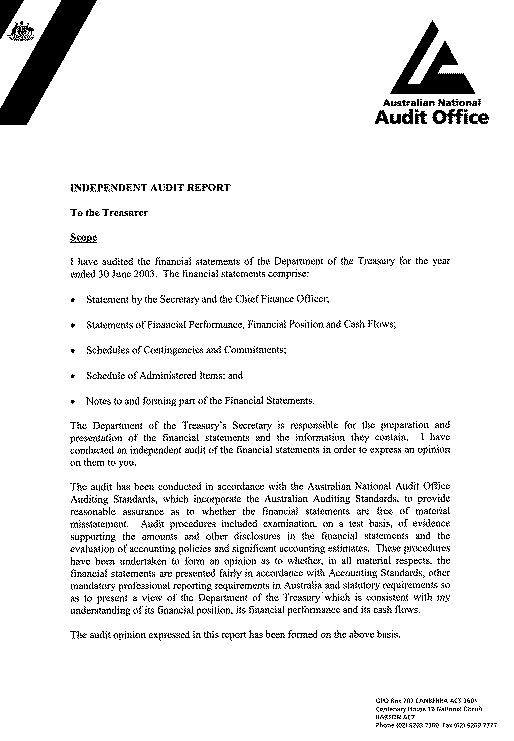
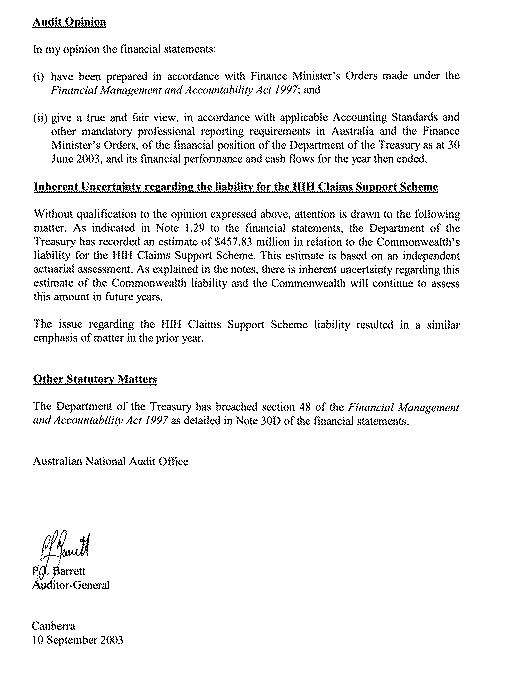
Department of the Treasury
Statement by the Departmental Secretary
Certification of financial statements
In my opinion, the attached financial statements for the year ended 30 June 2003 give a true and fair view of the matters required by the Finance Minister's Orders made under the Financial Management and Accountability Act 1997.
 |
 |
| Ken Henry | Michael Bott |
| Secretary to the Treasury | Chief Finance Officer |
| 8 September 2003 | 8 September 2003 |
Department of the Treasury statement of financial performance
for the year ended 30 June 2003
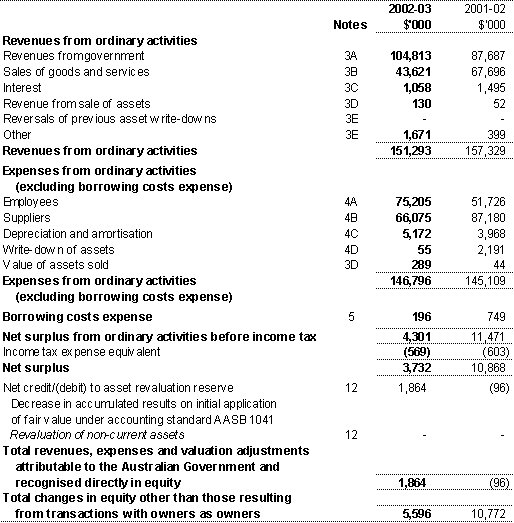
The above statement should be read in conjunction with the accompanying notes.
Department of the Treasury statement of financial position
as at 30 June 2003
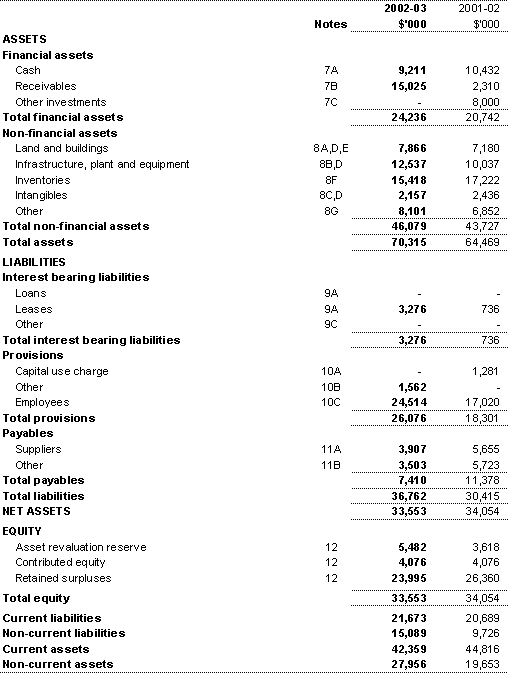
The above statement should be read in conjunction with the accompanying notes.
Department of the Treasury statement of cash flows
for the year ended 30 June 2003
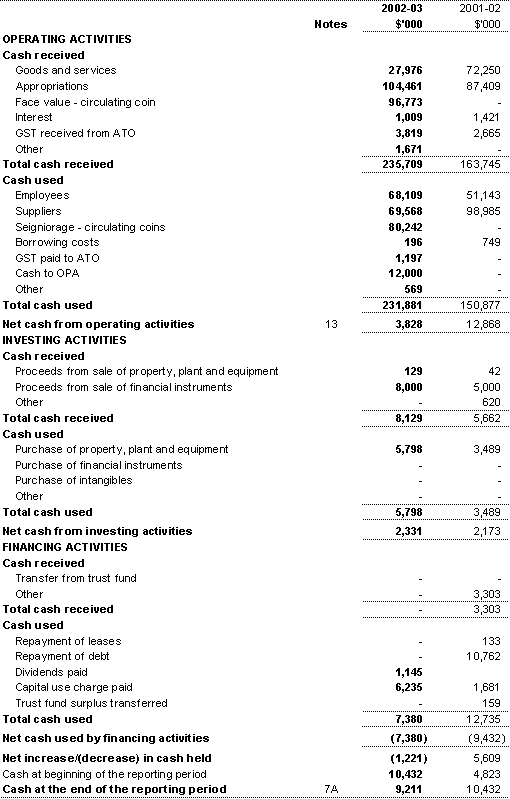
The above statement should be read in conjunction with the accompanying notes.
Schedule of commitments
as at 30 June 2003
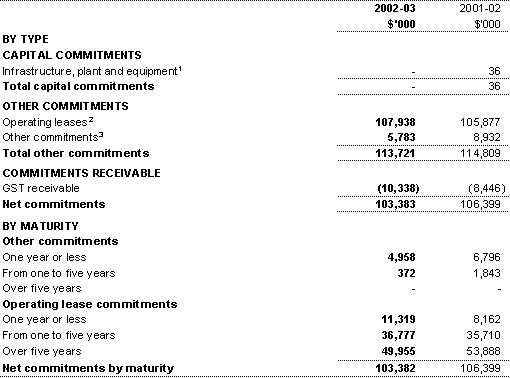
Note: Commitments are GST inclusive where relevant.
- Plant and equipment commitments are primarily contracts for purchases of furniture and fittings for new building.
- Operating leases included are effectively non-cancellable and comprise of :
| Nature of lease | General description of leasing arrangement |
| Leases for accommodation | Commercial - leases comprise various periods, including both initial and options periods.
|
| Agreements for the provision of motor vehicles to Senior Executive Officers |
|
| Leases for computer equipment |
|
- Other commitments includes commitments for contracted staff, electricity costs for the Treasury building, car lease expenses, and other miscellaneous commitments.
The above schedules should be read in conjunction with the accompanying notes.
Schedule of contingencies
as at 30 June 2003

(a) The amount represents an estimate of the department's liability based on precedent cases. The department is defending the claims.
(b) The department is expecting to succeed in claims, although the cases are continuing. The estimate is based on precedent in such cases.
Schedule of unquantifiable contingencies
As at 30 June 2003, the department had a number of legal claims outstanding. It is not possible to estimate the amounts of any eventual payments, which may be required in relation to these claims.
The above schedules should be read in conjunction with the accompanying notes.
Department of the Treasury schedule of administered items
for the year ended 30 June 2003
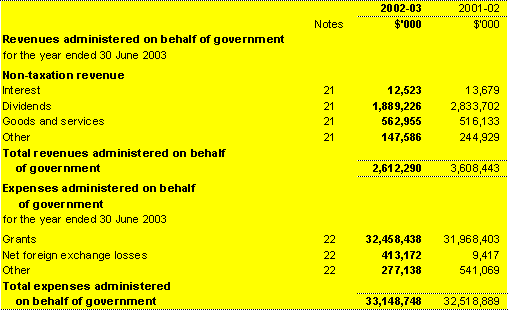
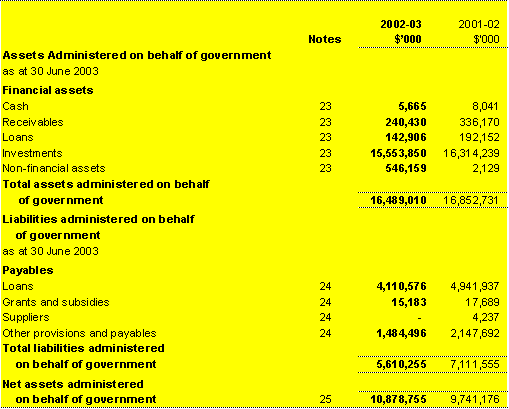
This schedule should be read in conjunction with the accompanying notes.
Administered cash flows
for the year ended 30 June 2003
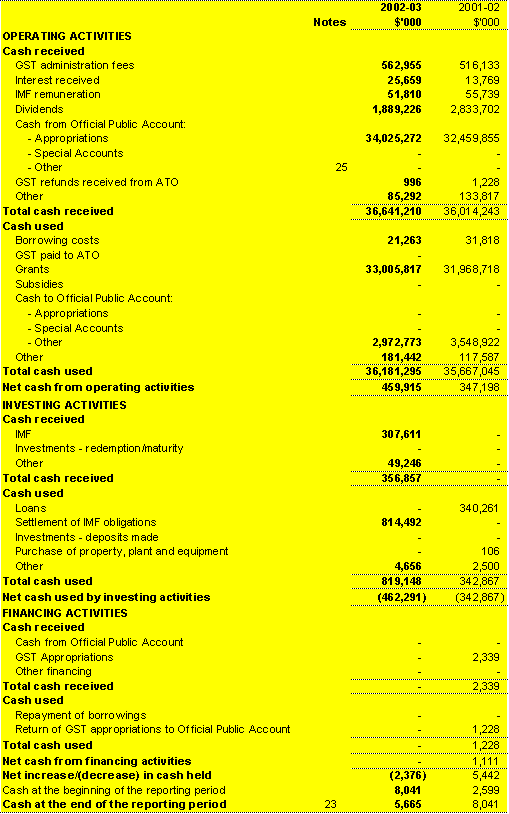
Administered commitments
as at 30 June 2003
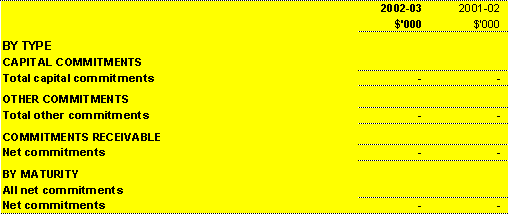
Note: All 2002-03 commitments are GST inclusive where relevant.
This schedule should be read in conjunction with the accompanying notes.
Administered contingencies
as at 30 June 2003

Note: Administered remote and unquantifiable contingencies are disclosed in Note 26: Administered Contingent Liabilities and Assets.
1 Other gurantees comprise of EBRD, IBRD, MIGA and ADB uncalled shares.
Statement of activities administered on behalf of government
The major administered activities of Treasury are directed towards achieving the three outcomes described in Note 1 to the Financial Statements. Details of planned activities for the year can be found in the Treasury Portfolio Budget Statements and Portfolio Additional Estimates Statements for 2002-03, which have been tabled in Parliament.
This schedule is to be read in conjunction with the accompanying notes.
Notes to and forming part of the financial statements
for the year ended 30 June 2003
Note 1: Summary of significant accounting policies
Note 2: Events occurring after balance date
Note 5: Borrowing cost expenses
Note 9: Interest bearing liabilities
Note 13: Cash flow reconciliation
Note 14: Contingent liabilities and assets
Note 15: Executive remuneration
Note 16: Remuneration of Auditors
Note 17: Average staffing levels
Note 18: Act of Grace payments, waivers and defective administration scheme
Note 20: Financial instruments
Note 21: Revenues administered on behalf of government
Note 22: Expenses administered on behalf of government
Note 23: Assets administered on behalf of government
Note 24: Liabilities administered on behalf of government
Note 25: Administered reconciliation table
Note 26: Administered contingent liabilities and assets
Note 27: Administered investments
Note 28: Administered financial instruments
Note 29: Administered consolidation
Note 31: Reporting of outcomes
Note 33: Related party transactions
Note 1: Summary of significant accounting policies
1.1 Objectives of the Department of the Treasury
The Department of the Treasury is structured to meet three outcomes:
Outcome 1: Sound macroeconomic environment;
Outcome 2: Effective government spending and taxation arrangements; and
Outcome 3: Well functioning markets.
The Department of the Treasury aims to improve the wellbeing of the Australian people. It does so by providing sound and timely advice to the government, based on objective and thorough analysis of options, and by assisting Treasury portfolio ministers in the administration of their responsibilities and implementation of government decisions.
The reporting entity comprises the Department of the Treasury, the Australian Government Actuary and the Royal Australian Mint (the Mint) hereafter referred to as `the department'.
Activities contributing toward the outcomes detailed above are classified as either departmental or administered. Departmental activities involve the use of assets, liabilities, revenues and expenses controlled or incurred by the department in its own right. Administered activities involve the management or oversight by the department on behalf of the government of items controlled or incurred by the government. For these purposes, the HIH Claims Support Limited (HCS) and the HIH Claims Support Scheme Trust have been included in the administered statements.
Only one output group is identified for each of Outcomes 1, 2 and 3. From 1 July 2003 Outcome 2 will have two output groups.
1.2 Basis of accounting
The financial statements are required by section 49 of the Financial Management and Accountability Act 1997 and are a general purpose financial report.
The statements have been prepared in accordance with:
- Finance Minister's Orders (or FMOs, being the Financial Management and Accountability (Financial Statements for reporting periods ending on or after 30 June 2003) Orders);
- Australian Accounting Standards and Accounting Interpretations issued by the Australian Accounting Standards Board; and,
- Consensus Views of the Urgent Issues Group.
The Statements of Financial Performance and Financial Position have been prepared on an accrual basis and are in accordance with historical cost convention, except for certain assets, which, as noted, are at valuation. Except where stated, no allowance is made for the effect of changing prices on the results or the financial position.
Assets and liabilities are recognised in the Statement of Financial Position when and only when it is probable that future economic benefits will flow and the amounts of the assets or liabilities can be reliably measured. However, assets and liabilities arising under agreements equally proportionately unperformed are not recognised unless required by an Accounting Standard. Liabilities and assets, which are unrecognised, are reported in the Schedule of Commitments and the Schedule of Contingencies (other than unquantifiable or remote contingencies, which are reported at Note 14).
Revenues and expenses are recognised in the Statement of Financial Performance when and only when the flow or consumption or loss of economic benefits has occurred and can be reliably measured.
The continued existence of the department in its present form, and with its present programs, is dependent on government policy and on continuing appropriations by Parliament for the department's administration and programs.
Administered revenues, expenses, assets and liabilities and cash flows reported in the Schedule of Administered Items and related notes are accounted for on the same basis and using the same policies as for Agency items, except where otherwise stated at Note 1.22.
1.3 Changes in accounting policy
The accounting policies used in the preparation of these financial statements are consistent with those used in 2001-02, except in respect of:
- the accounting for output appropriations (refer to Note 1.4);
- recognition of equity injections (refer to Note 1.5);
- measurement of certain employee benefits at nominal amounts (refer to Note 1.6);
- the initial revaluation of property plant and equipment on a fair value basis (refer to Note 1.12);
- the imposition of an impairment test for non-current assets carried at cost (refer to
Note 1.13); - recognition of seigniorage received from the Mint in the Departmental statement of cash flows (refer note 1.19);
- recognition of Provisions, Contingent Liabilities and Contingent Assets (refer to Note 1.29); and
- recognition of the Reserve Bank of Australia (RBA) contingent liability (refer Note 1.29).
1.4 Revenues
Revenues from government
Departmental outputs appropriations for the year (less any savings offered up in Portfolio Additional Estimates Statements) are recognised as revenue, except for certain amounts which relate to activities that are reciprocal in nature, in which case revenue is recognised only when it has been earned.
Resources received free of charge
Services received free of charge are recognised as revenue when and only when a fair value can be reliably determined and the services would have been purchased if they had not been donated. Use of those resources is recognised as an expense.
Contributions of assets at no cost of acquisition or for nominal consideration are recognised at their fair value when the asset qualifies for recognition, unless received from another government agency as a consequence of a restructuring of administrative arrangements.
Other revenue
Revenue from the sale of goods is recognised upon the delivery of goods to customers.
Revenue from rendering of services is recognised by reference to the stage of completion of contracts or other agreements to provide services. The stage of completion is determined according to the proportion that costs incurred to date bear to the estimated total costs of the transaction.
Interest revenue is recognised on a proportional basis taking into account the interest rates applicable to the financial assets.
Revenue from disposal of non-current assets is recognised when control of the asset has passed to the buyer.
1.5 Transactions by the government as owner
Equity injections
From 1 July 2002, the Finance Minister's Orders require that amounts of appropriations designated as `equity injections' (less any savings offered up in Portfolio Additional Estimates Statements) are recognised directly in Contributed Equity as at 1 July or later date of effect of the appropriation.
This is a change of accounting policy from 2001-02 to the extent any part of an equity injection that was dependent on specific future events occurring was not recognised until the appropriation was drawn down.
The change in policy has no financial effect in 2002-03 because the full amount of the equity injections for 2001-02 were recognised in that year.
Restructuring of administrative arrangements
Net assets received from or relinquished to another Australian Government agency or authority under a restructuring of administrative arrangements are adjusted at their book value directly against contributed equity.
Capital Use Charge
A Capital Use Charge of 11 per cent (2002: 11 per cent) is imposed by the government on the departmental net assets of the department at year end. The net assets figure is adjusted to take into account of asset gifts and revaluation increments during the financial year. The Charge is accounted for as a dividend to the government.
In accordance with the recommendations of the Budget Estimates and Framework Review, the government has decided that the charge will not operate after 30 June 2003.
Other distributions to owners
The Finance Minister's Orders require that distributions to owners be debited to contributed equity unless in the nature of a dividend.
1.6 Employee entitlements
Liabilities for services rendered by employees are recognised at the reporting date to the extent that they have not been settled.
Liabilities for wages and salaries (including non-monetary benefits), annual leave, sick leave are measured at their nominal amounts. Other employee benefits expected to be settled within 12 months of the reporting date are also measured at their nominal amounts.
The nominal amount is calculated with regard to the rates expected to be paid on settlement of the liability. This is a change in accounting policy from last year required by an initial application of a new Accounting Standard AASB 1028 from 1 July 2002. This change in accounting policy had an immaterial effect on employee benefits. All other employee benefit liabilities are measured at the present value of the estimated future cash outflows to be made in respect of services provided by employees up to the reporting date.
Leave
The liability for employee benefits includes provision for annual leave and long service leave. No provision has been made for sick leave as all sick leave is non-vesting and the average sick leave taken in future years by employees of the department is estimated to be less than the annual entitlement for sick leave.
The leave liabilities are calculated on the basis of employees' remuneration, including the department's employer superannuation contribution rates to the extent that the leave is likely to be taken during service rather than paid out on termination.
The liability for long service leave has been determined by reference to the work of an actuary as at 30 June 2003. The estimate of the present value of the liability takes into account attrition rates and pay increases through promotion and inflation.
Separation and redundancy
Provision is made for separation and redundancy benefit payments. The department where considered necessary, will develop a detailed formal plan for the terminations and inform those employees affected that it will carry out the terminations.
Superannuation
Staff of the department are members of the Commonwealth Superannuation Scheme and the Public Sector Superannuation Scheme. The liability for their superannuation benefits is recognised in the financial statements of the Australian Government and is settled by the Australian Government in due course.
The department makes employer contributions to the Australian Government at rates determined by an actuary to be sufficient to meet the cost to the Australian Government of the superannuation entitlements of the department's employees.
1.7 Leases
A distinction is made between finance leases which effectively transfer from the lessor to the lessee substantially all the risks and benefits incidental to ownership of leased non-current assets and operating leases under which the lessor effectively retains substantially all such risks and benefits.
Where a non-current asset is acquired by means of a finance lease, the asset is capitalised at the present value of minimum lease payments at the inception of the lease and a liability recognised for the same amount. Leased assets are amortised over the period of the lease. Lease payments are allocated between the principal component and the interest expense.
Operating lease payments are expensed on a basis, which is representative of the pattern of benefits derived from the leased assets. The net present value of future net outlays in respect of surplus space under non-cancellable lease agreements is expensed in the period in which the space becomes surplus.
1.8 Borrowing costs
All borrowing costs are expensed as incurred except to the extent that they are directly attributable to qualifying assets, in which case they are capitalised. The amount capitalised in a reporting period does not exceed the amounts of costs incurred in that period.
1.9 Cash
Cash means notes and coins held and any deposits held at call with a bank or financial institution.
1.10 Financial instruments
Accounting policies for financial instruments are stated at Notes 28A and 28B.
1.11 Acquisition of assets
Assets are recorded at cost on acquisition except as stated below. The cost of acquisition includes the fair value o
f assets transferred in exchange and liabilities undertaken.
Assets acquired at no cost, or for nominal consideration, are initially recognised as assets and revenues at their fair value at the date of acquisition, unless acquired as a consequence of restructuring of administrative arrangements. In the latter case, assets are initially recognised as contributions by owners at the amounts at which they were recognised in the transferor agency's accounts immediately prior to the restructuring.
1.12 Infrastructure, plant and equipment
Asset recognition threshold
Purchases of infrastructure, plant and equipment are recognised initially at cost in the department's Statement of Financial Position, except for purchases of less than $2,000 and computer equipment of less than $1,000. These are expensed in the year of acquisition (other than where they form part of a group of similar items, which are significant in total).
Revaluation
Basis
Land, buildings, plant and equipment are carried at valuation. Revaluations undertaken up to 30 June 2002 were performed on a deprival basis; revaluations since that date are at fair value. This change in accounting policy is required by Australian Accounting Standard AASB 1041 Revaluation of Non-Current Assets.
Fair and deprival values for each class of asset are determined as shown below.
| Asset Class | Fair Value Measured at: | Deprival value measured at: |
| Land | Market selling price | Market selling price |
| Buildings | Market selling price | Depreciated replacement cost |
| Leasehold improvements | Depreciated replacement cost | Depreciated replacement cost |
| Plant and equipment | Market selling price | Depreciated replacement cost |
| Heritage assets and artworks | Market selling price | Not applicable |
The department performed a valuation of buildings, infrastructure, plant and equipment on 30 June 2002. The valuation was performed by the Australian Valuation Office and was based on valuing assets using the deprival method of valuation.
The department had its heritage assets valued at 30 June 2003 by Herron, Todd and White (Canberra) Pty Ltd.
The Mint performed a valuation of infrastructure, plant and equipment (except master tooling) on 30 June 2001. The valuation was performed by the Australian Valuation Office and was based on valuing assets using the deprival method of valuation.
Master tooling was valued by an independent appraiser at 30 June 2003 and includes all dyes and plasters, although under the control of the Mint, not available to be sold or otherwise disposed of.
Under both deprival and fair value, assets, which are surplus to requirements, are measured at their net realiseable value.
Frequency
Infrastructure, plant and equipment are revalued progressively in successive three-year cycles. All current cycles commenced on 1 July 2001 and finish on 30 June 2004.
Acquisitions subsequent to the valuation are valued at historic cost.
Conduct
All valuations are conducted by an independent qualified valuer.
Depreciation
Depreciable property, plant and equipment assets are written-off to their estimated residual values over their estimated useful lives to the department using, in all cases, the straight-line method of depreciation. Leasehold improvements are depreciated on a straight-line basis over the lesser of the estimated useful life of the improvements or the unexpired period of the lease.
Depreciation rates (useful lives) and methods are reviewed at each reporting date and necessary adjustments are recognised in the current, or current and future reporting periods, as appropriate. Residual values are re-estimated for a change in prices only when assets are revalued.
Depreciation rates applying to each class of depreciable asset are based on the following useful lives:
|
2002-03 |
2001-02 |
|
| Computers, plant and equipment |
3-10 years |
3-10 years |
| Leasehold improvements |
5-10 years |
5-10 years |
| Motor vehicles |
4 years |
4 years |
| Office equipment |
5 years |
5 years |
| Capitalised software |
3-5 years |
3-5 years |
| Factory machinery |
10-20 years |
10-20 years |
The aggregate amount of depreciation allocated for each class of asset during the reporting period is disclosed in Note 4C.
Recoverable amount test
From 1 July 2002, the Schedule 1 no longer requires the application of the recoverable amount test in Australian Accounting Standard AAS 10 Recoverable Amount of Non-Current Assets to the assets of agencies when the primary purpose of the asset is not the generation of net cash inflows.
No property, plant and equipment assets other than land now held for sale have been written down to recoverable amount per AAS 10. Accordingly, the change in policy has had no financial effect.
1.13 Inventories
The department's intangibles comprise externally acquired software and internally developed software for internal use. These assets are carried at cost.
From 1 July 2002, Schedule 1 no longer requires the application of the recoverable amount test in Australian Accounting Standard AAS 10 Recoverable Amount of Non-Current Assets to the assets of agencies when the primary purpose of the asset is not the generation of net cash inflows.
However Schedule 1 now requires such assets, if carried on the cost basis, to be assessed for indications of impairment. The carrying amount of impaired assets must be written down to the higher of its net market selling price or depreciated replacement cost. Software is amortised on a straight-line basis over its anticipated useful life.
Useful lives are:
|
2002-03 |
2001-02 |
|
| Internally developed software |
2-5 years |
2-5 years |
1.14 Inventories
Inventories held for resale are valued at the lower of cost and net realisable value. Work in progress and finished goods are brought to account to include direct costs and a proportion of direct labour and overhead. All precious metals are purchased and brought to account at cost and expensed as used. Indirect materials are expensed at time of purchase.
Inventories not held for resale are valued at cost, unless they are no longer required, in which case they are valued at net realiseable value.
1.15 Taxation
The department is exempt from all forms of taxation except for Fringe Benefits Tax and Goods and Services Tax. The Mint is liable for Fringe Benefits Tax and Goods and Services Tax on sales of products and via a tax equivalent payment to the Department of the Treasury for Payroll Tax and Company Income Tax. Companies Income Tax became applicable for the first time in 1998-99, as a result of the competitive neutrality arrangements.
Revenues expenses and assets are recognised net of GST, except for receivables and payables, and where the amount of GST incurred is not recoverable from the Australian Taxation Office.
1.16 Foreign currency
Transactions denominated in a foreign currency are converted at the exchange rate at the date of the transaction. Foreign currency receivables and payables are translated at the exchange rates current as at balance date.
1.17 Insurance
The department has insured for risks through the government's insurable risk managed fund, called Comcover. Workers' compensation is insured through the government's Comcare Australia.
1.18 Rounding
Amounts are rounded to the nearest $1,000 except in relation to the following items:
- act of grace payments and waivers;
- Appropriations, special accounts and special public monies;
- remuneration of executives; and
- remuneration of auditors.
1.19 Royal Australian Mint - seigniorage and repurchase of circulating coins
Seigniorage is collected by the Mint on behalf of the Australian Government. Seigniorage represents the difference between the face value of coinage sold to the Reserve Bank of Australia and its cost of production to the Mint.
The Mint repurchases circulating coins on behalf of the Australian Government. The costs incurred by the Mint in repurchasing circulating coins are offset to an extent by the sale of scrap metal and the balance is supplemented by the Australian Government through a reduction in the total amount paid to the Australian Government.
The revenues from circulating coin sales are not directly available to be used by the Mint for its own purposes and are remitted to the Australian Government's Official Public Account.
Change in accounting policy reporting of seignorage cash-flow.
From 2002-03 the departmental statement of cash-flow has recognised for the first time the inflow and outflow of costs associated with the collection of seignorage for the Australian Government.
1.20 Investment in Sydney 2000 Olympic Coin Program
The Royal Australian Mint and the Perth Mint were joint venturers in the Sydney 2000 Olympic Coin Program (STOCP), marketing and distributing Sydney 2000 Olympic Coins. This joint venture concluded in June 2002.
1.21 Economic dependency
The Mint is economically dependent on the Reserve Bank of Australia for the purchase of circulating coin.
1.22 Reporting of administered items
Administered revenues, expenses, assets, liabilities and cash flows are disclosed in the Schedule of Administered Items and related Notes.
Except where otherwise stated below, administered items are accounted for on the same basis and using the same policies as for departmental items, including the application to the greatest extent possible of Accounting Standards, Accounting Interpretations and Urgent Issues Group Consensus Views.
Administered appropriations received or receivable from the Official Public Account are not reported as administered revenues or assets respectively. Similarly, administered receipts transferred or transferable to the Official Public Account are not reported as administered expenses or payables. These transactions or balances are internal to the Administered entity.
These transfers of cash are reported as administered (operating) cash flows and in the administered reconciliation table in Note 25.
Accounting policies which are relevant to administered activities are disclosed below.
1.23 Revenue
All administered revenues are revenues relating to the core operating activities performed by the department on behalf of the Australian Government.
Reserve Bank of Australia dividend
Dividends from the Reserve Bank of Australia are recognised when a determination is made by the Treasurer. Dividend revenue is brought to account once the right to control the income stream is established. On this basis, the Reserve Bank of Australia's dividend for 2002-03 will be recognised in Treasury's Financial Statements in 2003-04.
The amount of the dividend for 2002-03 was $2.397 billion.
Interest on Papua New Guinea loan
The interest on the outstanding principal amount is paid annually in arrears, due on 30 June every year until paid in full. The department received $11.872 million in interest payments for 2002-03.
International Monetary Fund remuneration
Remuneration is interest paid by the International Monetary Fund to Australia for the use of its funds. It includes the proportion of the quota that was paid in special drawing rights and held by the Fund and money lent out under the Financial Transaction Plan.
Payments under The New Tax System (Commonwealth- State Financial Arrangements) Act 1999
The outcome of the taxation reform process is a taxation system, which provides a stable and equitable revenue source to fund governmental services essential to the wellbeing of Australians. Special appropriations relating to this legislation fall under three categories, GST Payments to the States, Budget Balancing Assistance Grants and National Competition Policy Payments.
1.24 Administered capital
Appropriations of `administered capital' are recognised in administered equity as the amounts appropriated by Parliament are drawn down.
1.25 Grants
The department administers a number of grant schemes on behalf of the government.
Grant liabilities are recognised to the extent that (i) the services required to be performed by the grantee have been performed or (ii) the grant eligibility criteria have been satisfied.
A commitment is recorded when the government has a binding agreement to make the grants but services have not been performed or criteria satisfied.
Grants to states and territories
The introduction of The New Tax System on 1 July 2000 has significantly reformed payments made under Commonwealth-State financial relations. Treasury has responsibility for administering these payments.
The largest payment is the provision of GST revenue. The Australian Government pays to the States all GST collected, and commenced monthly payments of GST revenue to the States in July 2000. GST revenue payments to the States in 2002-03 were distributed in accordance with relativities recommended by the Commonwealth Grants Commission. Treasury also administered General Revenue Assistance payments to the States and Territories consisting of Budget Balancing Assistance, National Competition Policy Payments and Special Revenue Assistance in 2002-03.
Budget Balancing Assistance arises from the Australian Government's guarantee that in each of the transitional years following the introduction of the GST, each State's budgetary position will be no worse off than had the reforms in the Intergovernmental Agreement on the Reform of Commonwealth-State Financial Relat
ions not been implemented.
National Competition Policy Payments to the States and Territories are conditional on the States and Territories meeting their obligations under the agreement to implement the national competition policy and related reforms.
Special Revenue Assistance was provided to the ACT in recognition that certain Commonwealth-State financial relations differ from Commonwealth-ACT financial relations in certain specific respects.
As a consequence of the Australian Taxation Office collecting GST for distribution to the States, the States make payments to the Australian Government to meet the agreed costs incurred in administering the GST. The department is responsible for collection of GST administration fees from the States and Territories.
A new First Home Owners Scheme commenced on 1 July 2000. Under the First Home Owners Scheme, a grant of $7,000 is available to eligible applicants who are buying or building their first home. The First Home Owners Scheme is administered by the States on the basis of principles agreed to by all jurisdictions in the Intergovernmental Agreement.
On 9 March 2001, the Australian Government announced that an additional $7,000 grant, fully funded by the Australian Government, would be available for first home owners building or purchasing new but previously unoccupied homes before 31 December 2001. In December 2001, the government announced a phase down of the additional grant making it available for a further six months, from 1 January 2002, at a reduced rate of $3,000 per grant. The additional grant ceased on 30 June 2002, while the original scheme will continue to offer $7,000 grants to eligible first home buyers. The government also announced that more liberal construction commencement and completion requirements will apply to additional First Home Owners Scheme grants for contracts made on or after 9 October 2001.
Mirror taxes collected by state and territory governments
On behalf of the States, the Australian Government imposes mirror taxes, which replace State taxes in relation to Australian Government places that may be constitutionally invalid. Mirror taxes are collected by the States and are paid to the Australian Government and immediately repaid to the States. State governments bear the administration costs of collecting mirror taxes.
1.26 Administered investments
Development banks
Once crystalised, investments in development banks are classified as non-monetary assets and owing to their nature, these investments are not revalued. As such, these investments are recognised at historical cost where the information is available. Where historical cost related cost records are not readily available, a notional cost has been established at 30 June 1993 by reference to the development banks' financial statements and exchange rates at that time.
Initial investments in the Asian Development Bank (prior to 1995), the International Finance Corporation (prior to 1991), and the International Bank for Reconstruction and Development (prior to 1988) have been recognised at notional cost. Any subsequent capital subscriptions to these development banks have been recognised at historical cost.
Investments in the European Bank for Reconstruction and Development and the Multilateral Investment Guarantee Agency are recognised at historical cost.
International Monetary Fund
The quota is the current value in Australian dollars of Australia's subscription to the International Monetary Fund.
The Special Drawing Rights allocation liability reflects the current value in Australian dollars of the liability to repay to the International Monetary Fund. This is classified as `Other payables'.
Portfolio agencies
The Australian Government's investment in other controlled authorities and companies in this portfolio is valued at the aggregate of the Australian Government's share of the net assets and net liabilities of each entity as at 30 June 1997. Where Australian Government entities controlled by the portfolio came into existence after 30 June 1997, the investment is valued at the Australian Government's share of capital contributions by Government at the date of inception.
1.27 Promissory notes
Promissory notes have been issued to the International Monetary Fund, International Bank for Reconstruction and Development, the European Bank for Reconstruction and Development, the Asian Development Bank and the Multilateral Investment Guarantee Agency.
Where promissory notes have been issued in foreign currencies, they are translated at the spot rate at balance date. Foreign currency gains and losses are recognised where applicable.
1.28 Mortgage insurance policies written by the Housing Loans Insurance Corporation up to 12 December 1997
The Australian Government sold the Housing Loans Insurance Corporation on 12 December 1997. Terms and conditions of the sale included that the Australian Government shall remain responsible for the mortgage insurance policies written up to the time of the sale.
The sale of the Housing Loans Insurance Corporation was conducted by the Office of Asset Sales and Information Technology Outsourcing.
Accounting policies adopted are:
Premiums
Premiums comprise amounts charged to the policyholder or other insurer, excluding amounts collected on behalf of third parties, principally stamp duties. The earned portion of premiums received and receivable is recognised as revenue. Premiums are treated as earned from the date of attachment of risk.
Premiums received in respect of insured loans are apportioned over a number of years in accordance with an actuarial determination of the pattern of risk in relation to the loans. Premium amounts carried forward in this way are credited to `Provision for unearned premiums'.
Recoveries
Claims incurred recoveries and a receivable for outstanding recoveries are recognised in respect of insurance policies. The asset is assessed on an actuarial basis and covers recoveries incurred but not yet received, incurred but not yet reported and the anticipated direct and indirect costs of settling those claims. The asset (Housing Loans Insurance Corporation premiums receivable) has been recognised in Note 21C, based on the estimated discounted future cash flows.
Claims
Claims incurred expense and a liability for outstanding claims are recognised in respect of insurance policies. The liability is assessed on an actuarial basis and covers claims incurred but not yet paid, incurred but not yet reported and the anticipated direct and indirect costs of settling those claims. The liability has been recognised based on the estimated discounted future cash flows.
Acquisition costs
A portion of acquisition costs relating to unearned premium revenue is deferred in recognition that it represents future benefits. Deferred acquisition costs are amortised on an actuarial basis over the reporting periods expected to benefit from the expenditure.
1.29 Provisions and contingent liabilities
HIH Claims Support Scheme liability
HIH Claims Support Limited was established by the Insurance Council of Australia as a not-for-profit company to provide Australian Government funded assistance to policyholders suffering financial hardship as a result of the failure of the HIH Group Companies, and the appointment on 15 March 2001 of the Provisional Liquidators of the HIH Group Companies. The HIH Claims Support Trust was established in order to perform its obligations under the Australian Government Management Agreement dated 6 July 2001. As the beneficiary of this trust, the Australian Government is entitled to any residual balance of the trust, after the collection of recoveries and making of payments to claimants.
An actuarial assessment was conducted by an independent actuary as at 31 March 2003, and the results of the review indicated that the overall cost of the scheme discounted to present val
ue is estimated to be $732 million. This estimate incorporates an allowance for future inflation and provides for the estimated costs of both the claim handling expenses and the scheme management fees.
There is inherent uncertainty regarding the measurement of the Australian Government liability. One of the key results of the independent actuarial assessment was that due to the relative immaturity of the scheme, and because at the time of the assessment a significant portion of the major claim types were yet to be reviewed by the claims managers, the result remains highly uncertain and requires close monitoring. As the scheme matures, this element of the uncertainty should reduce.
The Australian Government will continue to assess the estimated liability in future years. Further assessments will also include quantifying possible recoveries to be made by HIH Claims Support Limited, which is acting as the Trustee on behalf of the Australian Government in relation to the HIH Claims Support Scheme.
Change in accounting policy - initial adoption of AASB 1044 `Provisions, Contingent Liabilities and Contingent Assets'
The department has adopted the treatment of provisions of AASB 1044 in 2002-03. This has led to the department discounting the provision for the overall cost of the scheme to present value for the first time in this financial year. The cumulative financial effect of the change has been adjusted directly against the opening balance of accumulated results in line with the specific transitional provisions in AASB 1044. The amount of the adjustment was a decrease of $120.737 million to the value of the provision.
Remote contingency Reserve Bank of Australia
The Australian Government guarantees all monies that are, or has at any time become, payable, to a person other than the Australian Government. The department has changed the methodology for calculating this remote contingency to exclude Financial Management and Accountability Act 1997 Agency deposits. The effect of this change in accounting policy for 2002-03 is to reduce the remote contingency by $13.784 billion.
United Medical Protection Limited and Australasian Medical Insurance Limited
Following the decision on 29 April 2002 by the Boards of United Medical Protection Limited and Australasian Medical Insurance Limited to seek the appointment of a provisional liquidator, the Australian Government committed to providing an indemnity to the provisional liquidator, the terms of which were set out in a letter from the Minister for Health and Ageing to medical practitioners, dated 1 May 2002 and in the Prime Minister's subsequent press release of 31 May 2002.
During 2002-03 the government has transferred responsibility for administering this liability to the Department of Health and Ageing. This has led to an adjustment of $500.8 million directly against administered equity.
Note 2: Events occurring after balance date
1 The Reserve Bank of Australia has calculated a dividend of $2.397 billion in respect of its results for the year ended 30 June 2003. The Treasurer will ratify the payment in accordance with the recommendation of the Reserve Bank of Australia's Board of Directors. As a consequence, Treasury will record this dividend income in its accounts for the year ended 30 June 2004 in accordance with its accounting policy (Note 1.23).
2. On 1 July 2003 the Australian Reinsurance Pool Corporation was created under the Terrorism Insurance Act 2003. For further information please refer to Note 26 Administered Contingent Liabilities and Assets.
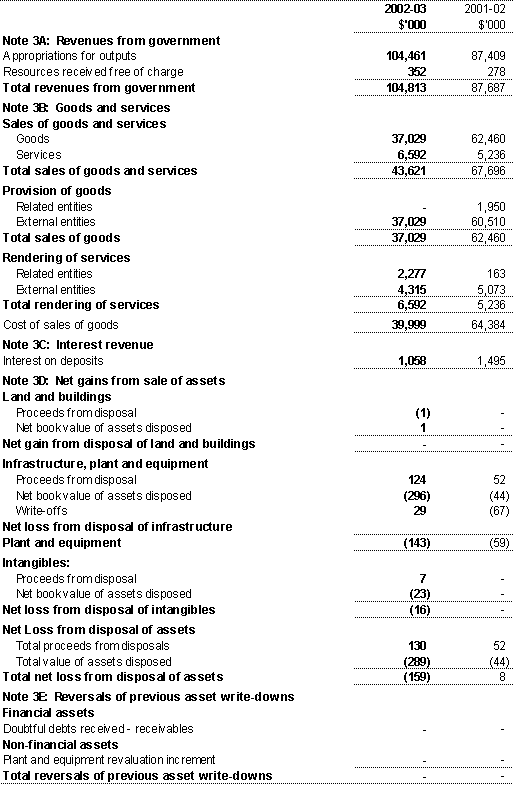
Note 3: Operating revenues (continued)

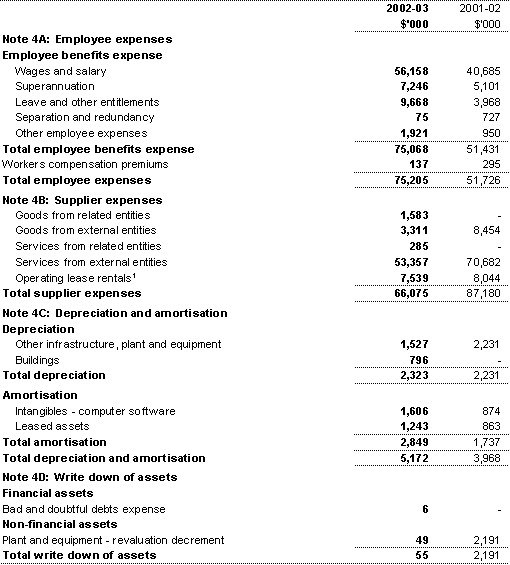
1 These comprise minimum lease payments only.
Note 5: Borrowing cost expenses

The Mint operates via a special account. Payments made from this account are for the purposes of business operations. The balance of the special account is disclosed at Note 30D.
The Australia Government Actuary operates via a special account. Payments made from this account are for the purposes of business operations. The balance of the special account is disclosed at Note 30D. The Australian Government Actuary has been granted an exemption under Sub Clause 1B.1 (C) of the 2002-03 Finance Minister's Orders for the preparation of a complete set of 2002-03 Financial Statements on materiality grounds. The exemption has been approved by the Minister for Finance and Administration.
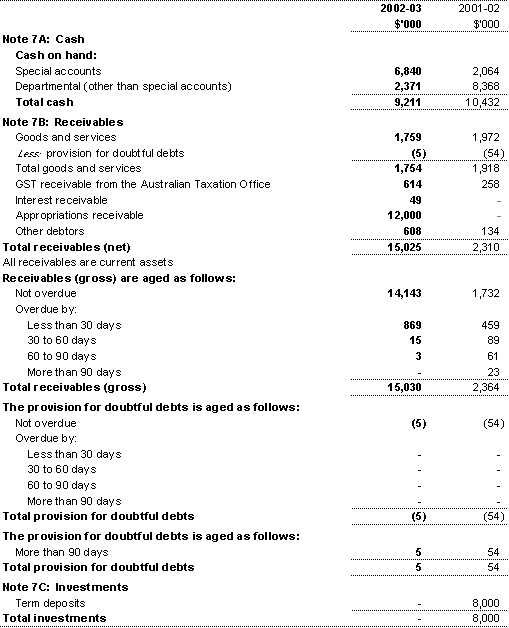
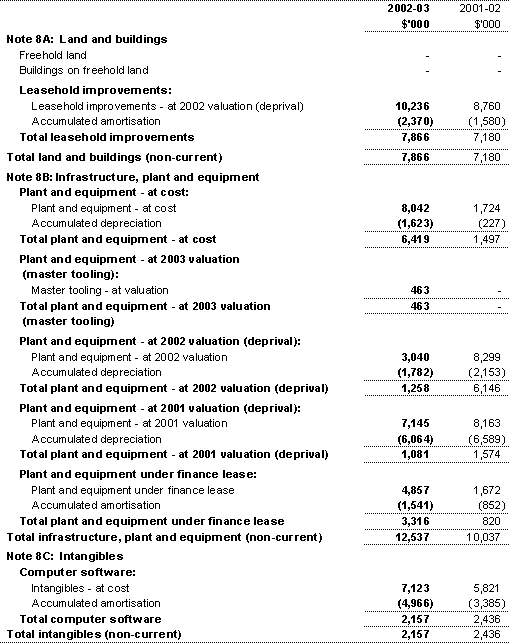
Note 8: Non-financial assets (continued)
Note 8D: Analysis of property, plant, equipment and intangibles
Table A: Reconciliation of the opening and closing balances of property, plant, equipment and intangibles
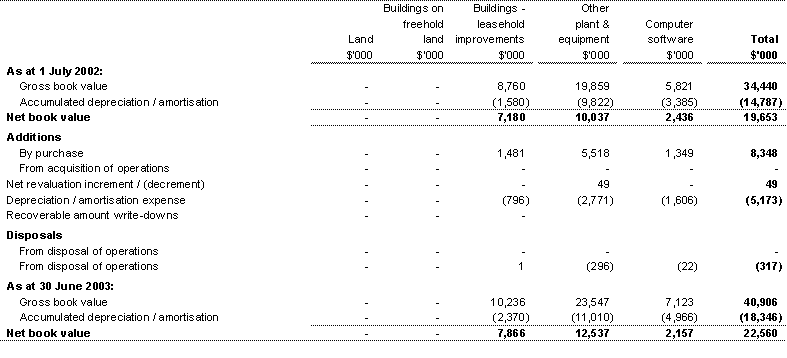
Note 8: Non-financial assets (continued)
Note 8E: Analysis of property, plant, equipment and intangibles
Table B: Assets at valuation

Note: This table does not include assets purchased in 2002-03 as these assets are held at cost.
Table C: Assets held under finance lease

Note: This table does not include assets purchased in 2002-03 as these assets are held at cost.
Note 8: Non-financial assets (continued)
Note 8E: Analysis of property, plant, equipment and intangibles (continued)
Table D: Assets under construction

Note 8: Non-financial assets (continued)
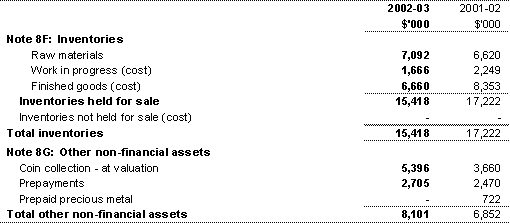
Note: Other non-financial assets except for the coin collection are current assets
Note 9: Interest bearing liabilities
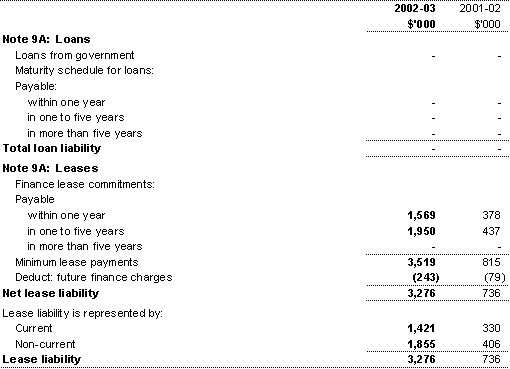
Finance leases exist in relation to certain major office equipment assets. The leases are non-cancellable and for fixed terms averaging three years, with a maximum of five years. The department guarantees the residual
values of all assets leased. There are no contingent rentals.
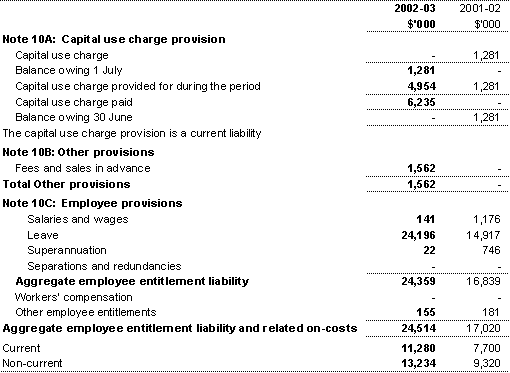
Note: The Capital Use Charge has been abolished from 1 July 2003.
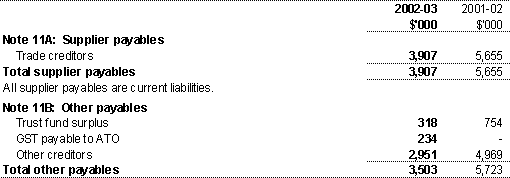
Note: All other payables are current liabilities.
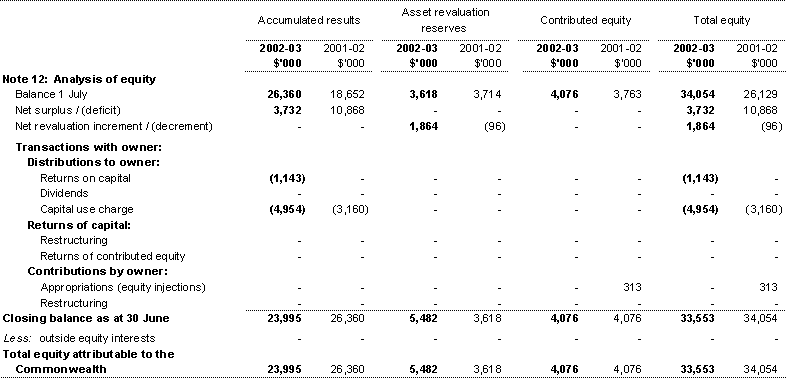
Note: Return on capital in 2002-03 relates to monies returned to Government due to the cessation of the Agency Banking Incentive Scheme (ABIS).
Note 13: Cash flow reconciliation
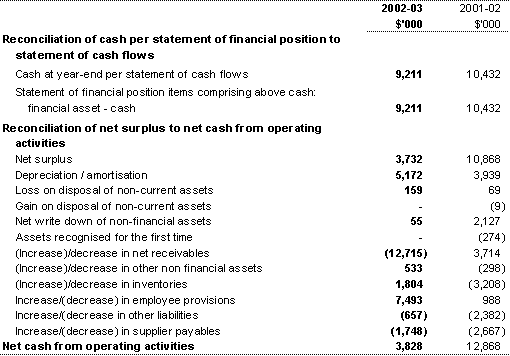
Note 14: Contingent liabilities and assets
Quantifiable Contingencies
The Schedule of Contingencies reports liabilities in respect of claims for damages/costs of $400,000 (2002: $400,000). The amount represents an estimate of Treasurer's liability based on precedent cases. Treasury is defending the claim.
The Schedule also reports contingent assets in respect of claims for damages/costs of $7,000 (2002: $80,000). Treasury is expecting to succeed in claims against suppliers, although the cases are continuing. The estimate is based on precedent cases.
Remote Contingencies
The Treasury has no remote contingencies.
Note 15: Executive remuneration
Total remuneration includes actual salary, all allowances, employer superannuation component, vehicle costs and an estimate of the non-salary component of the Senior Executive Service package.
The number of senior executives who received or were due to receive total remuneration of $100,000 or more:
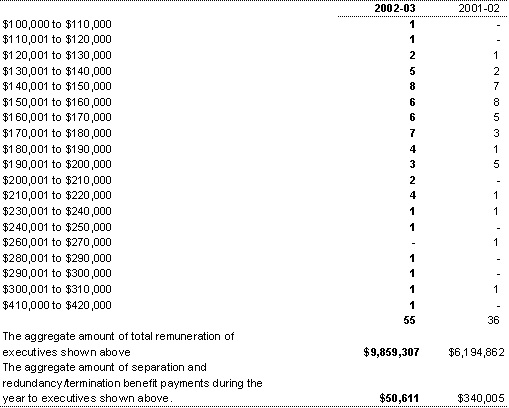
Note 16: Remuneration of Auditors

Note: the above amounts are exclusive of GST. No other services were provided by the Auditor General.
Note 17: Average staffing levels

Note 18: Act of Grace payments, waivers and
defective administration scheme

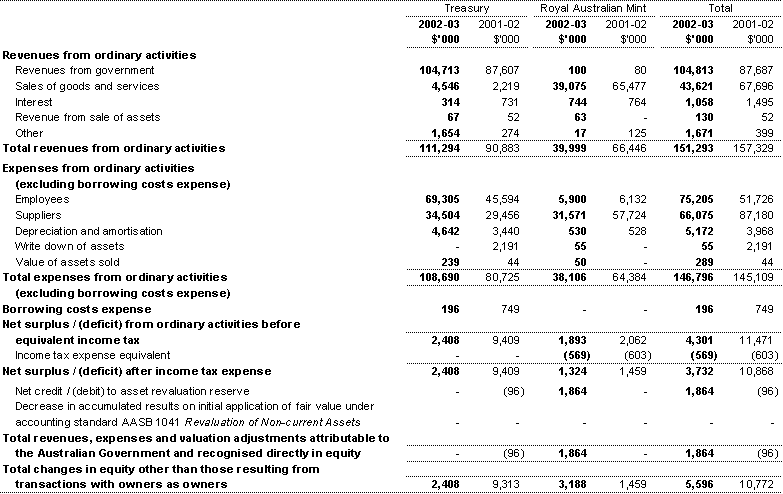
Note: The above amounts have been consolidated into the department's balances shown in these financial statements.
Note 19: Consolidation (continued)
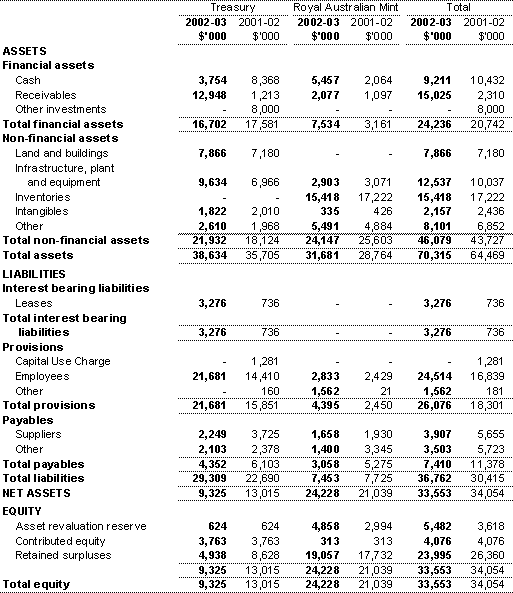
Note: The above amounts have been consolidated into the department's balances shown in these financial statements.
Note 20: Financial instruments
Note 20A: Terms, conditions and accounting policies
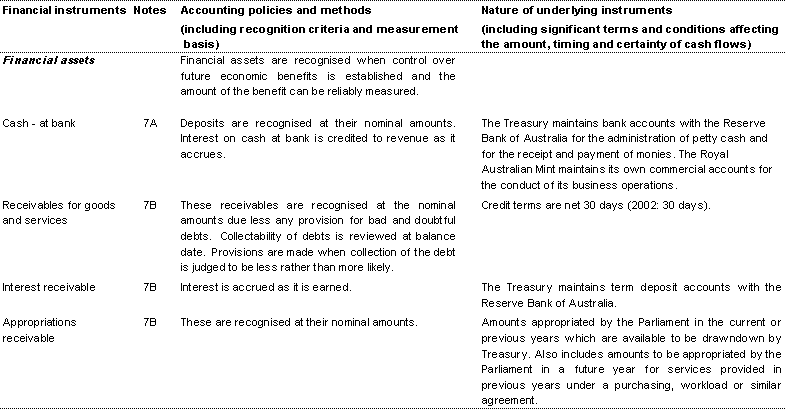
Note 20: Financial instruments (continued)
Note 20A: Terms, conditions and accounting policies (continued)
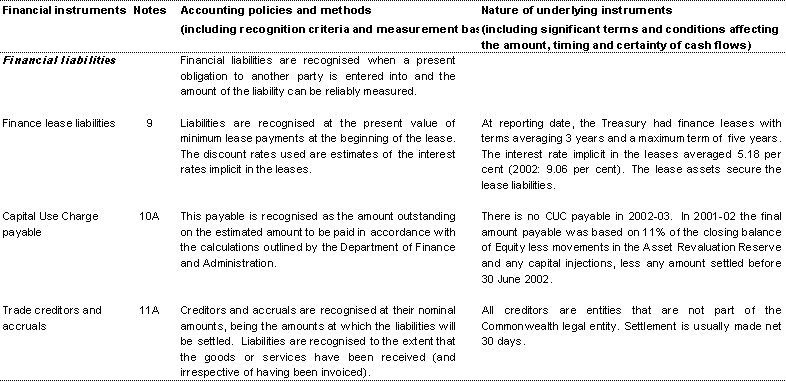
Note 20: Financial instruments (continued)
Note 20B: Interest rate risk
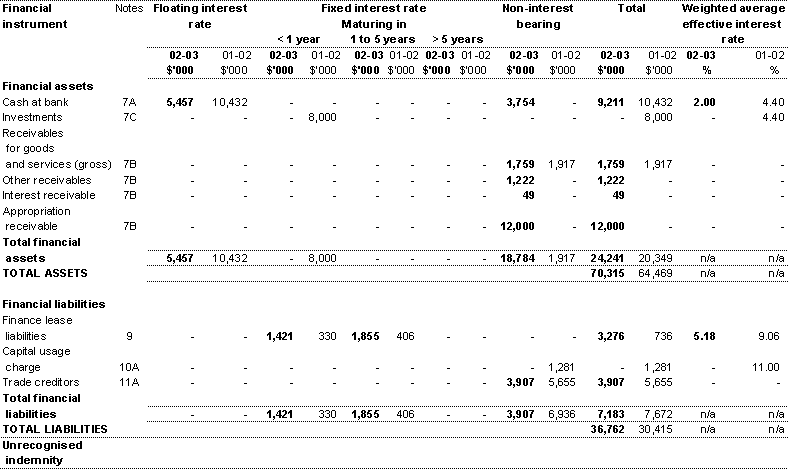
Note 20: Financial instruments (continued)
Note 20C: Net fair values of financial assets and liabilities
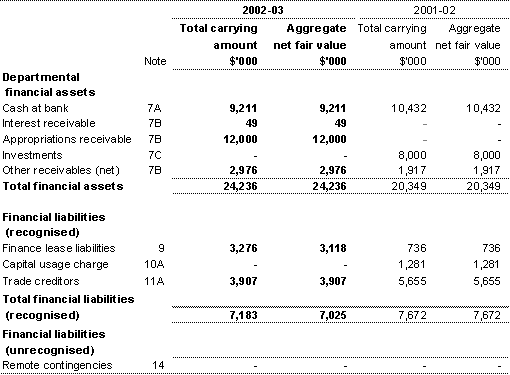
The net fair values of cash and non-interest bearing monetary financial assets approximate their carrying amounts.
The net fair values of the finance lease and government loan liabilities are based on discounted cash flows using current interest rates for liabilities with similar risk profiles.
The net fair values for trade creditors are approximated by their carrying amounts.
The net fair value of the indemnity given is taken to be nil as the likelihood of any part of it being called upon is regarded as remote.
Note 20: Financial Instruments (continued)
Note 20D: Credit risk exposures
The department's maximum exposures to credit risk at reporting date in relation to each class of recognised financial assets is the carrying amount of those assets as indicated in the Statement of Financial Position.
The department has no significant exposures to any concentrations of credit risk.
The Mint has no significant exposures to any concentrations of credit risk.
All figures for credit risk referred to do not take into account the value of any collateral or other security.
Note 21: Revenues administered on behalf of government
for the year ended 30 June 2003
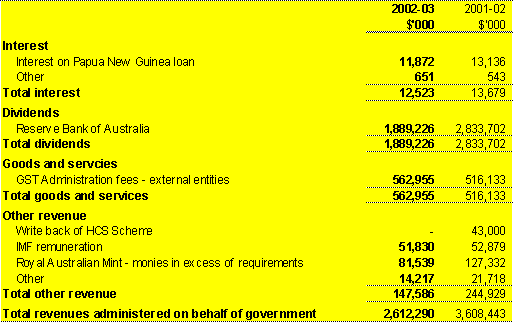
Note 22: Expenses administered on behalf of government
for the year ended 30 June 2003
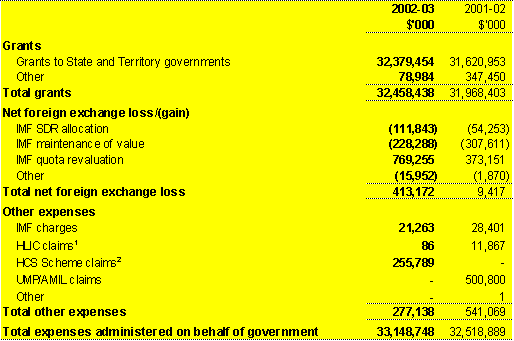
1. HLIC claims expenses include payments and management fees.
2. HCS Scheme claims expenses include payments and management fees.
Note 23: Assets administered on behalf of government
as at 30 June 2003
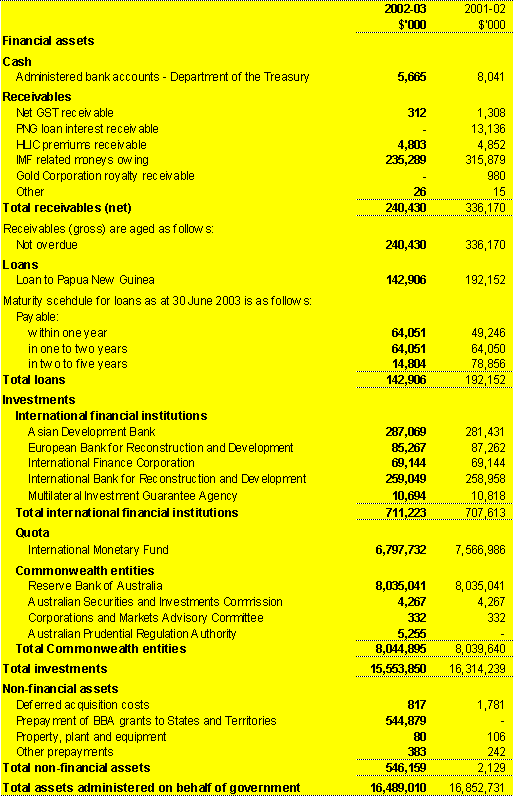
Note 24: Liabilities administered on behalf of government
as at 30 June 2003
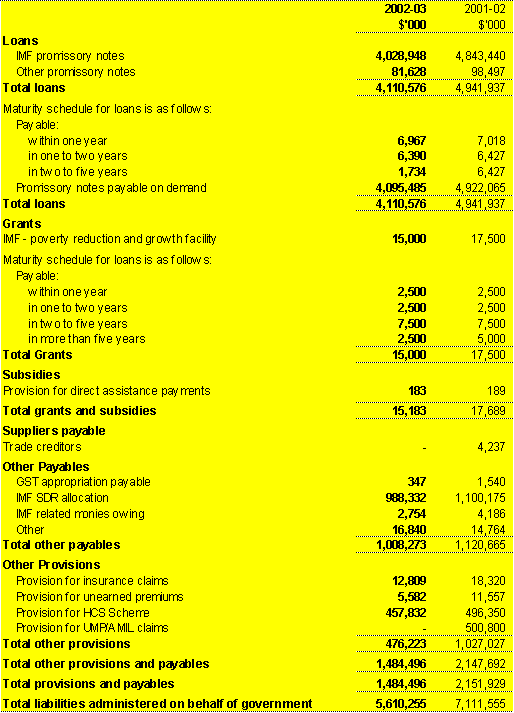
Note 25: Administered reconciliation table
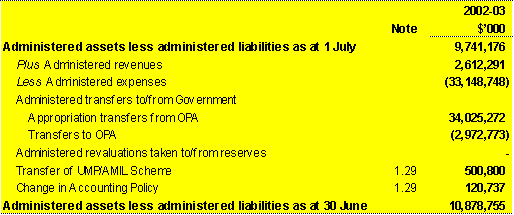
Note 26: Administered contingent liabilities and assets
Quantifiable administered contingencies
Quantifiable Administered Contingencies that are not remote are disclosed in the Schedule of Administered Items as Quantifiable Administered Contingenci
es.
Quantifiable administered contingencies.
Unquantifiable administered contingencies
Terrorism insurance - Australian Reinsurance Pool Corporation (ARPC)
The scheme will provide a pool of funds (initially planned to accumulate to about $300 million) generated by reinsurance premiums paid to the ARPC. The pool will be supplemented by a back up line of credit of $1 billion, underwritten by the Commonwealth, as well as a Commonwealth Government indemnity of $9 billion, giving aggregate cover of up to $10.3 billion when the fund is fully funded. Under the Terrorism Insurance Bill 2002, the Commonwealth guarantees the payment of liabilities incurred by the ARPC. The ARPC may recoup payouts under the scheme by increasing premiums for terrorism insurance, and pass these funds on to the Commonwealth. However, such repayments to the Commonwealth may take some years.
Contingent gain
As a beneficiary of the HIH Claims Support Trust, the Commonwealth will be entitled to the residual balance of the Trust, after the collection of recoveries and making of payments to claimants. Due to the inherent uncertainty regarding the measurement of the recoveries, it is not possible to quantify these amounts at this time.
Note 26: Administered contingent liabilities and assets (continued)
Remote administered contingencies
Guarantees
The following borrowings have been guaranteed by the Commonwealth in respect of authorities within the Treasury portfolio:
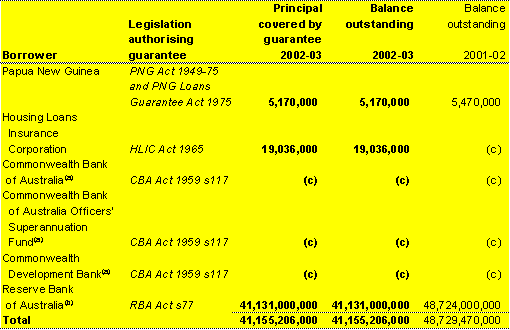
(a) Under the terms of the Commonwealth Bank Sale Act 1995, the Commonwealth has guaranteed various liabilities of the Commonwealth Bank of Australia (CBA), the Commonwealth Bank Officers' Superannuation Corporation (CBOSC) and the Commonwealth Development Bank. The guarantee for the CBA relates to both on and off balance sheet liabilities. The guarantee of the CBOSC covers the due payments of any amount that is payable to or from Officers' of the Superannuation Fund (the Fund), by CBOSC or by CBA, in respect of a person who was a member, retired member or beneficiary of the Fund immediately before 19 July 1996. As of 1 July 1996 the Commonwealth Development Bank ceased to write new business and no additional liabilities are being incurred. The existing contingent liability will gradually decline with the retirement of existing loans and exposures.
(b) The contingent liability for the Reserve Bank of Australia, (RBA) relates to the Commonwealth's guarantee of the RBA It is measured as the Bank's total liabilities excluding capital, reserves and Commonwealth deposits. The RBA Guarantee for 2001-02 includes Commonwealth deposits.
(c) At the finalisation of these statements this was not reliably measurable.
HIH Claims Support Scheme
The Commonwealth has a number of indemnities and guarantees in respect of the HIH Support Scheme.
Note 27: Administered investments
The principal activities of each of Treasury's administered investments are as follows:
Development Banks
Investments in development banks are classified as non-monetary assets and owing to their nature, these investments are not revalued. As such, these investments are recognised at historical cost where the information is available. Where historical cost records are not readily obtainable, a notional cost has been established at 30 June 1993 by reference to the development banks' financial statements and exchange rates at the time. Initial investments in the European Bank for Reconstruction and Development, Asian Development Bank, the International Finance Corporation and the International Bank for Reconstruction and Development have been recognised at notional cost. Subsequent capital subscriptions have been recognised at historical cost. Investment in the Multilateral Investment Guarantee Agency is recognised at historical cost.
International Monetary Fund
The quota is the current value in Australian dollars of Australia's subscription to the International Monetary Fund.
The Special Drawing Rights allocation liability reflects the current value in Australian dollars of the liability to repay to the IMF Australia's cumulative allocation of SDRs, and is classified as 'Other payables'.
Portfolio Agencies
The Commonwealth's investment in other controlled authorities and companies in this portfolio is valued at the aggregate of the Commonwealth's share of the net assets and net liabilities of each entity as at 30 June 1997. Where the Commonwealth entities controlled by the portfolio came into existence after 30 June 1997. The investment is valued at the Commonwealth's share of capital contributions by Government at the date of inception.
Note 28: Administered financial instruments
(a) Terms, conditions and accounting policies
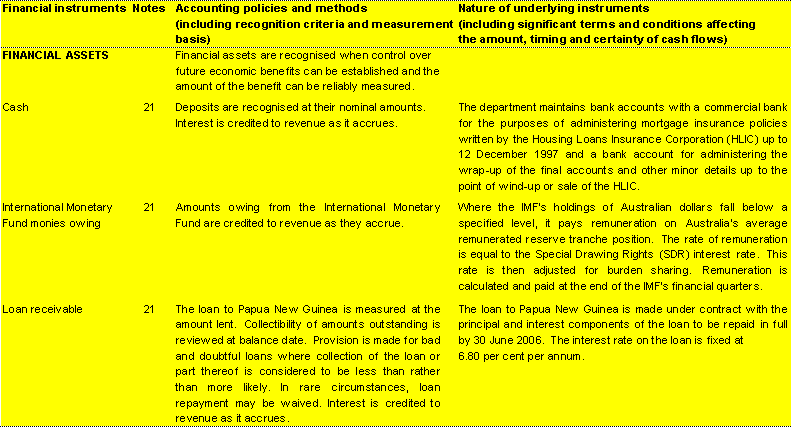
Note 28: Administered financial instruments (continued)
(a) Terms, conditions and accounting policies (continued)
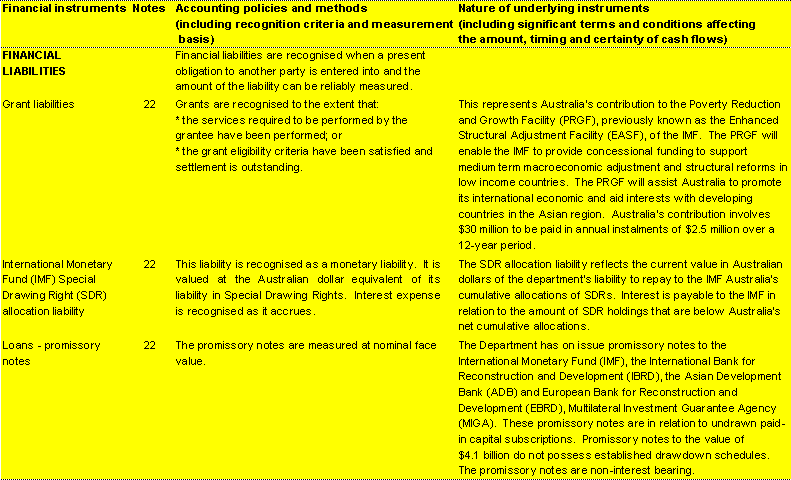
Note 28: Administered financial instruments (continued)
(a) Terms, conditions and accounting policies (continued)
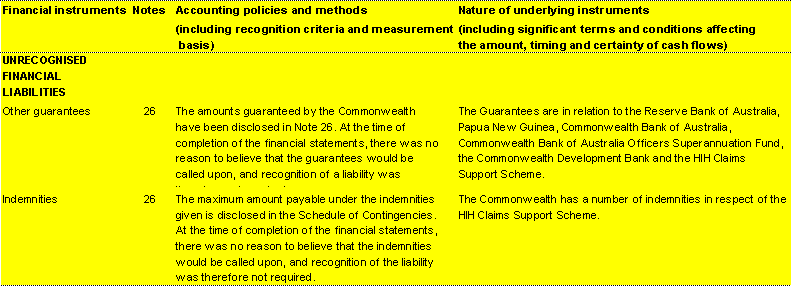
Note 28: Administered financial instruments (continued)
(b) Administered interest rate risk
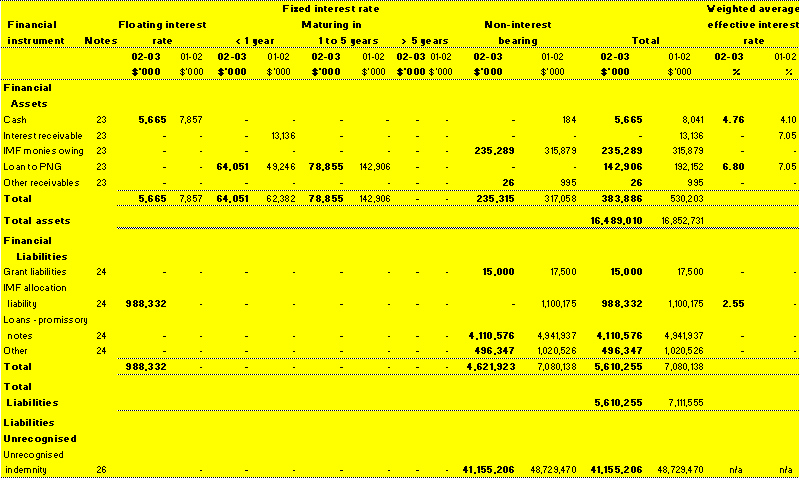
Note 28: Administered financial instruments (continued)
(c) Net fair values of financial assets and liabilities
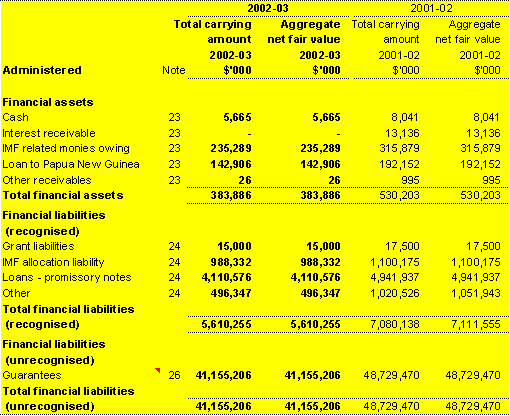
Financial assets
The net fair values of cash and non-interest-bearing monetary financial assets approximate their carrying amounts. The net fair value of loans receivable are based on discounted cash flows using current interest rates for assets with similar risk profiles. Loan to Papua New Guinea is carried at cost which is above their net fair value. It is intended that all loans will be held until maturity.
Financial liabilities
The net fair values of unrecognised guarantees and indemnities are subsequently below the Government's maximum exposure, because the likelihood that they will be called upon has been assessed as remote.
The net fair values for trade creditors and grant liabilities are short-term in nature and are approximated by their carrying amounts.
Note 29: Administered consolidation
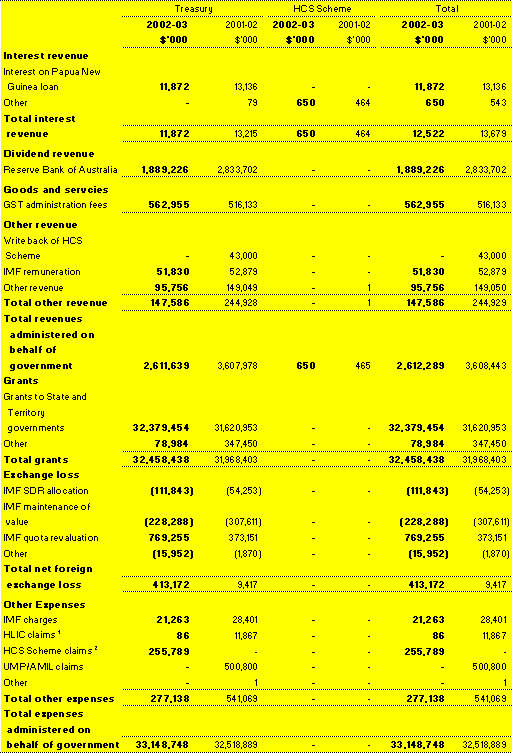
1 HLIC claims expenses include payments and management fees.
2 HCS Scheme claims expenses include payments and management fees.
Note 29: Administered consolidation (continued)
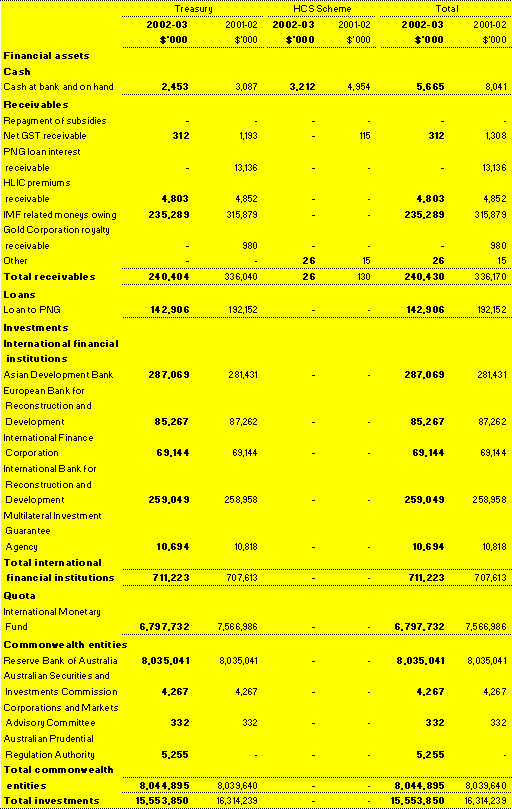
Note 29: Administered consolidation (continued)
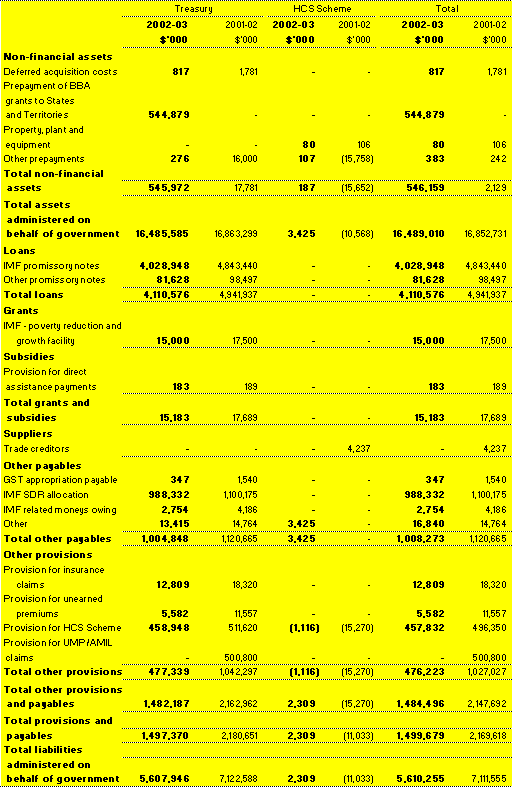
Note 30A: Cash basis acquittal of appropriations from Acts 1 and 3
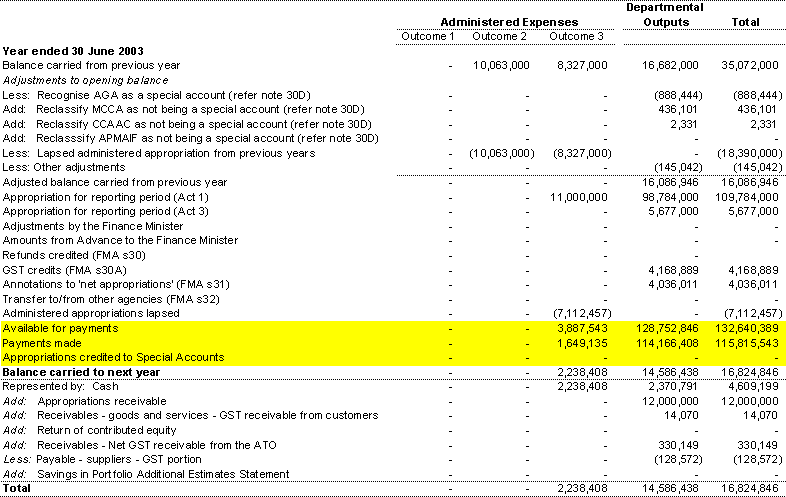
Any amounts of administered appropriations for 2002-03 shown above as lapsed are estimates only as determinations are not made by the Finance Minister until after the completion of these statements.
Note 30: Appropriations (continued)
Note 30A: Cash basis acquittal of appropriations from Acts 1 and 3 (continued)
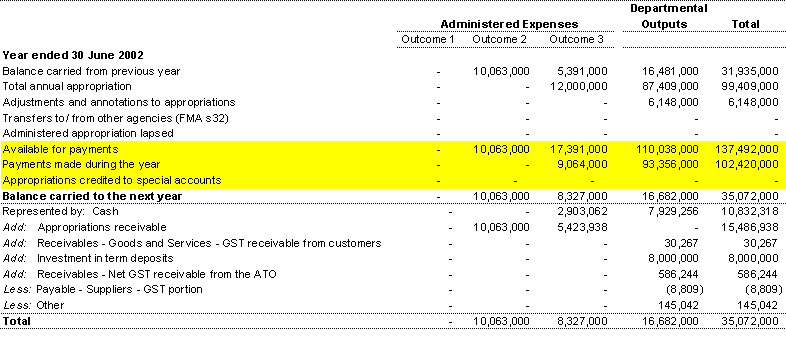
Note 30: Appropriations (continued)
Note 30B: Cash basis acquittal of appropriations from Acts 2 and 4
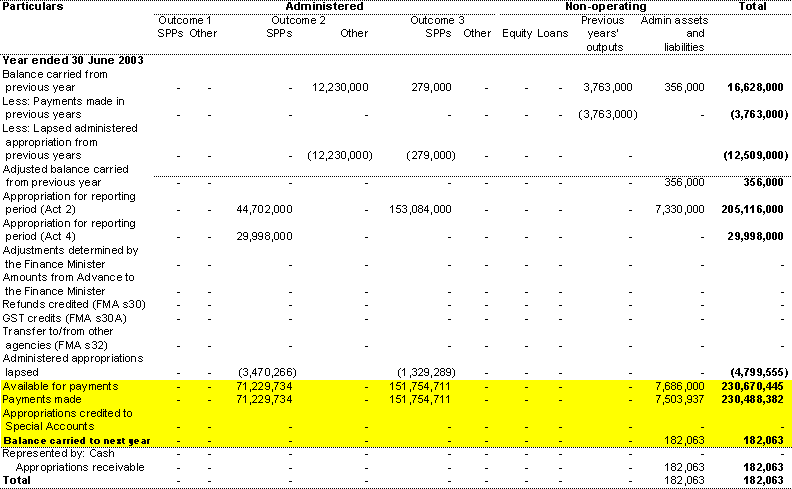
Any amounts of administered appropriations for 2002-03 shown above as lapsed are estimates only as determinations are not made by the Finance Minister until after the completion of these statements.
Note 30: Appropriations (continued)
Note 30B: Cash basis acquittal of appropriations from Acts 2 and 4 (continued)
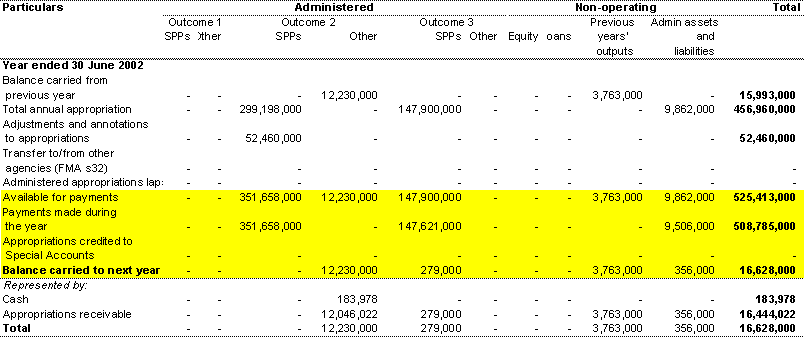
Note 30: Appropriations (continued)
Note 30C: Cash basis acquittal of special appropriations (unlimited amount)
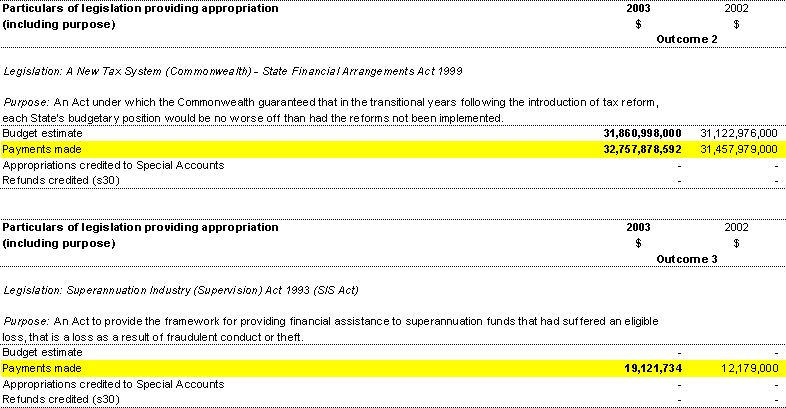
Note 30: Appropriations (continued)
Note 30C: Cash basis acquittal of special appropriations (unlimited amount) (continued)
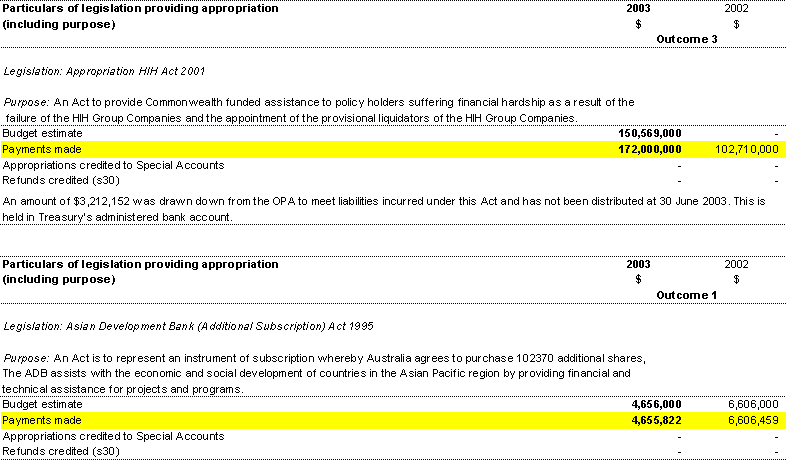
Note 30: Appropriations (continued)
Note 30C: Cash basis acquittal of special appropriations (unlimited amount) (continued)
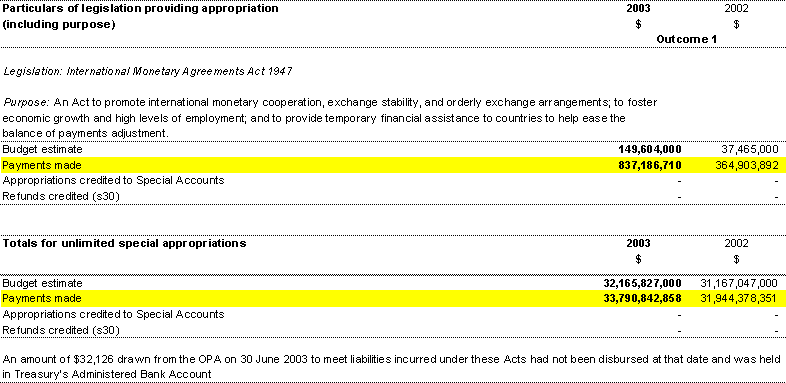
Note 30: Appropriations (continued)
Note 30D: Special accounts

Note 30: Appropriations (continued)
Note 30D: Special accounts (continued)
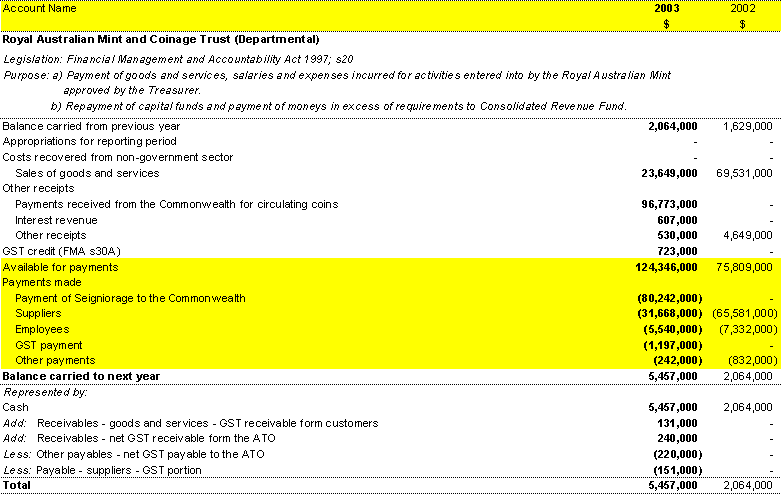
Note 30: Appropriations (continued)
Note 30D: Special accounts (continued)
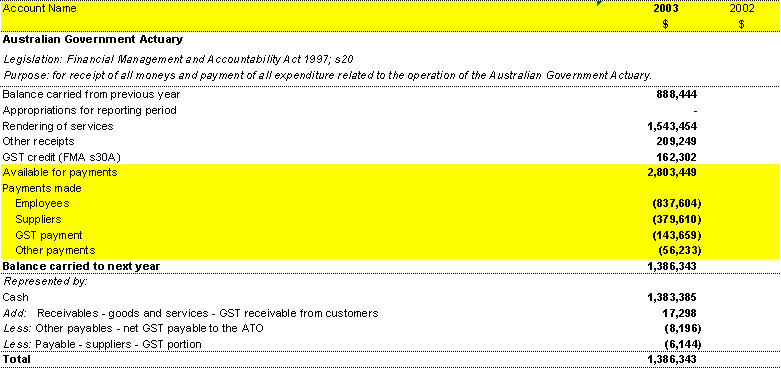
Note: The AGA was not disclosed as a special account in 2001-02. This has resulted in an adjustment to the AGA special account opening balance for 2002-03.
Note 30: Appropriations (continued)
Note 30D: Special accounts (continued)
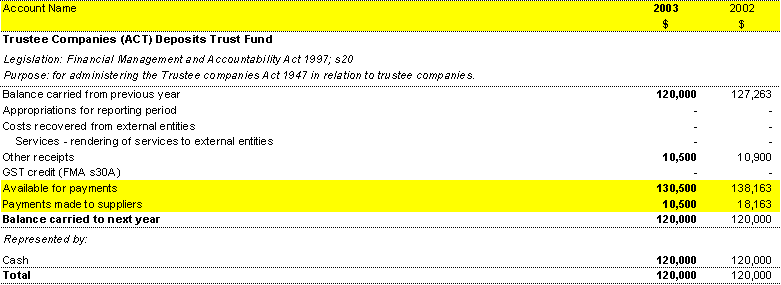
Note: The Trustee Companies (ACT) Deposits Trust Fund was disclosed under special public monies in 2001-02. Given that the Trust is also a special account, it has been disclosed in the special accounts note.
Note 30: Appropriations (continued)
Note 30D: Special accounts (continued)
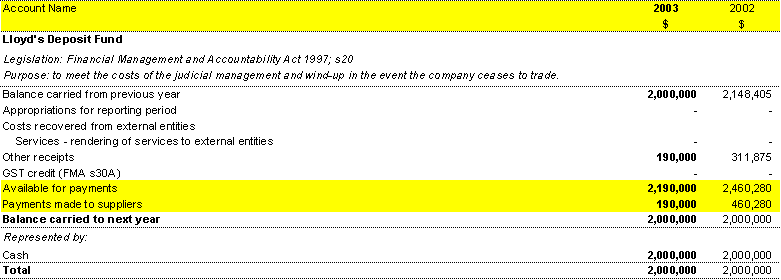
Note: The Lloyld's Deposits Fund was disclosed under special public monies in 2001-02. The fund has been reclassified as a special account in 2002-03.
Services for Other Governments and Non Agency Bodies Account
Treasury has a 'Services for Other Governments and Non Agency Bodies Account'. For the years ended 30 June 2002 and 30 June 2003 this special account had nil balances and no transaction were credited or debited to the account.
Note 30: Appropriations (continued)
Note 30D: Special accounts (continued)
During 2002-03, three special accounts were identified as not having the appropriate Determination as required by section 20 of the Financial Management and Accountability Act 1997 (FMA Act). These accounts are the Ministerial Council on Consumer Affairs (MCCA), the Commonwealth Consumer Affairs Advisory Council (CCAAC) and the Advisory Panel for Marketing in Australia of Infant Formula (APMAIF). As there is no available evidence that these accounts were determined to be special accounts under s20 of the FMA Act and to remove any doubt as to their legal existence, these accounts were abolished by the Minister for Finance and Administration on 25 June 2003. The department has disclosed these accounts as "special accounts" from 1999-00 to 2001-02. While the payments have now been correctly disclosed, the department is in breach of section 48 of the FMA Act as prior year financial statements disclosed receipts and payments incorrectly as special accounts. The total value of payments made from these accounts from 1 July 1999 to 30 June 2002 was $815,421. Payments made in 2002-03 were $102,168.
Note 31: Reporting of outcomes
Treasury uses a process of cost allocation to estimate the costs of each output identified in Note 31. The cost of each output is comprised of direct and indirect costs. Direct costs are assigned to outputs according to detailed cost profiles. Indirect costs that comprise corporate and overhead items such as information technology, accommodation and human resource management are allocated to outputs based on a (cost driver) consumption basis.
Note 31: Reporting of outcomes (continued)
Note 31A: Net cost of outcome delivery
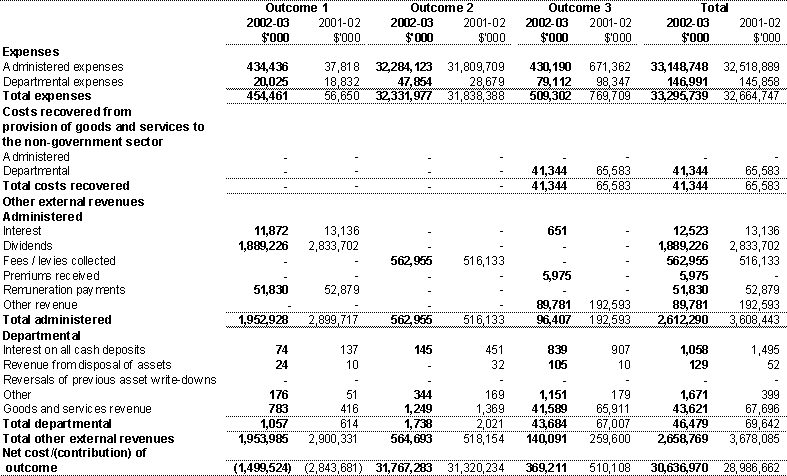
Outcomes 1, 2 and 3 are described in Note 1.1 Net costs shown include intra-government in calculating the actual Budget outcome. The Capital Usage Charge is not included in any of the outcomes as it is not an operating expense in end-of-year financial reports.
Note 31: Reporting of outcomes (continued)
Note 31B: Major classes of departmental revenues and expenses by output group and outputs
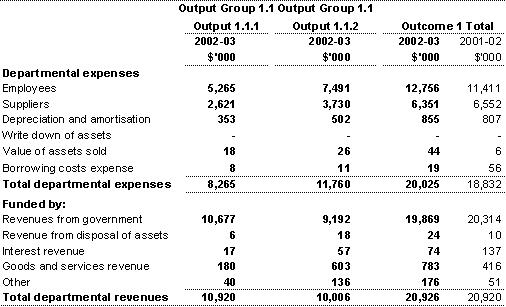
Note 31: Reporting of outcomes (continued)
Note 31B: Major classes of departmental revenues and expenses by output group and outputs (continued)
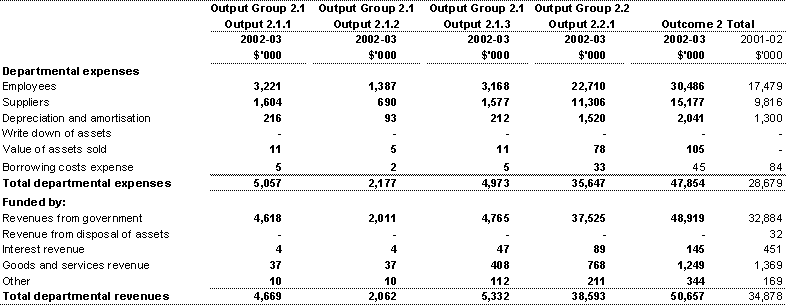
Note 31: Reporting of outcomes (continued)
Note 31B: Major classes of departmental revenues and expen
ses by output group and outputs (continued)
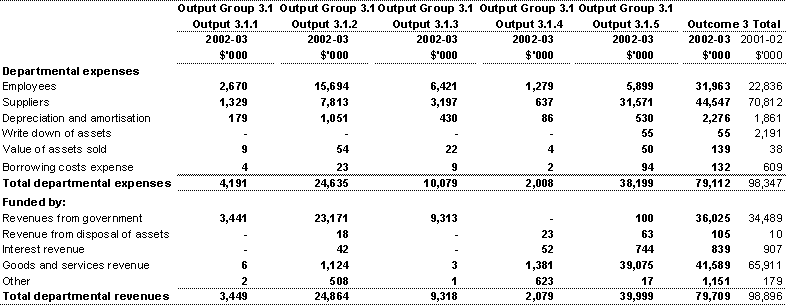
Note 31: Reporting of outcomes (continued)
Note 31C: Major classes of administered revenues and expenses by outcomes

Comcare Trust Account
Legal Authority
Financial Management and Accountability Act 1997, section 20
Purpose
Monies held in a trust and advanced to the Treasury by Comcare for the purpose of distributing compensation payments made in accordance with the Safety Rehabilitation and Compensation Act 1998.

Note 33: Related party transactions
